SCHS097F November 1998 – March 2017 CD40106B
PRODUCTION DATA.
- 1 Features
- 2 Applications
- 3 Description
- 4 Revision History
- 5 Pin Configuration and Functions
- 6 Specifications
- 7 Parameter Measurement Information
- 8 Detailed Description
- 9 Application and Implementation
- 10Power Supply Recommendations
- 11Layout
- 12Device and Documentation Support
- 13Mechanical, Packaging, and Orderable Information
Package Options
Mechanical Data (Package|Pins)
Thermal pad, mechanical data (Package|Pins)
Orderable Information
6 Specifications
6.1 Absolute Maximum Ratings
over operating free-air temperature range (unless otherwise noted)(1)| MIN | MAX | UNIT | ||
|---|---|---|---|---|
| DC supply voltage, VDD(2) | –0.5 | 20 | V | |
| Input voltage, all inputs | –0.5 | VDD + 0.5 | V | |
| DC input current, any one input | ±10 | mA | ||
| Power dissipation, PD | TA = –55°C to +100°C | 500 | mW | |
| TA = 100°C to 125°C(3) | 200 | |||
| Device dissipation per output transistor | 100 | mW | ||
| Maximum junction temperature, TJ | 150 | °C | ||
| Storage temperature, Tstg | –65 | 150 | °C | |
(1) Stresses beyond those listed under Absolute Maximum Ratings may cause permanent damage to the device. These are stress ratings only, which do not imply functional operation of the device at these or any other conditions beyond those indicated under Recommended Operating Conditions. Exposure to absolute-maximum-rated conditions for extended periods may affect device reliability.
(2) Voltages referenced to VSS terminal
(3) Derate linearity at 12 mW/°C
6.2 ESD Ratings
| VALUE | UNIT | |||
|---|---|---|---|---|
| V(ESD) | Electrostatic discharge | Human-body model (HBM), per ANSI/ESDA/JEDEC JS-001(1) | 2000 | V |
| Charged-device model (CDM), per JEDEC specification JESD22-C101(2) | 1000 | |||
(1) JEDEC document JEP155 states that 500-V HBM allows safe manufacturing with a standard ESD control process.
(2) JEDEC document JEP157 states that 250-V CDM allows safe manufacturing with a standard ESD control process.
6.3 Recommended Operating Conditions
over operating free-air temperature range (unless otherwise noted)| MIN | MAX | UNIT | |
|---|---|---|---|
| Supply voltage | 3 | 18 | V |
| Operating temperature, TA | –55 | 125 | °C |
6.4 Thermal Information
| THERMAL METRIC(1) | CD40106B | UNIT | ||||
|---|---|---|---|---|---|---|
| D (SOIC) | N (PDIP) | NS (SO) | PW (TSSOP) | |||
| 14 PINS | 14 PINS | 14 PINS | 14 PINS | |||
| RθJA | Junction-to-ambient thermal resistance |
86.1 | 51.3 | 83.5 | 114.1 | °C/W |
| RθJC(top) | Junction-to-case (top) thermal resistance |
44.3 | 38.6 | 41.5 | 39.1 | °C/W |
| RθJB | Junction-to-board thermal resistance |
40.6 | 31.2 | 42.2 | 56.9 | °C/W |
| ψJT | Junction-to-top characterization parameter |
11.6 | 23.4 | 13.1 | 3.1 | °C/W |
| ψJB | Junction-to-board characterization parameter |
40.3 | 31.3 | 41.8 | 56.2 | °C/W |
(1) For more information about traditional and new thermal metrics, see the Semiconductor and IC Package Thermal Metrics application report.
6.5 Electrical Characteristics: Static
over operating free-air temperature range (unless otherwise noted)| PARAMETER | TEST CONDITIONS | MIN | TYP | MAX | UNIT | ||
|---|---|---|---|---|---|---|---|
| IDDmax | Quiescent device current | VIN = 0 or 5, VDD = 5 | TA = –55°C | 1 | µA | ||
| TA = –40°C | 1 | ||||||
| TA = 25°C | 0.02 | 1 | |||||
| TA = 85°C | 30 | ||||||
| TA = 125°C | 30 | ||||||
| VIN = 0 or 10, VDD = 10 | TA = –55°C | 2 | |||||
| TA = –40°C | 2 | ||||||
| TA = 25°C | 0.02 | 2 | |||||
| TA = 85°C | 60 | ||||||
| TA = 125°C | 60 | ||||||
| VIN = 0 or 15, VDD = 15 | TA = –55°C | 4 | |||||
| TA = –40°C | 4 | ||||||
| TA = 25°C | 0.02 | 4 | |||||
| TA = 85°C | 120 | ||||||
| TA = 125°C | 120 | ||||||
| VIN = 0 or 20, VDD = 20 | TA = –55°C | 20 | |||||
| TA = –40°C | 20 | ||||||
| TA = 25°C | 0.04 | 20 | |||||
| TA = 85°C | 600 | ||||||
| TA = 125°C | 600 | ||||||
| VPmin | Positive trigger threshold voltage | VDD = 5 | TA = –55°C | 2.2 | V | ||
| TA = –40°C | 2.2 | ||||||
| TA = 25°C | 2.2 | 2.9 | |||||
| TA = 85°C | 2.2 | ||||||
| TA = 125°C | 2.2 | ||||||
| VDD = 10 | TA = –55°C | 4.6 | |||||
| TA = –40°C | 4.6 | ||||||
| TA = 25°C | 4.6 | 5.9 | |||||
| TA = 85°C | 4.6 | ||||||
| TA = 125°C | 4.6 | ||||||
| VDD = 15 | TA = –55°C | 6.8 | |||||
| TA = –40°C | 6.8 | ||||||
| TA = 25°C | 6.8 | 8.8 | |||||
| TA = 85°C | 6.8 | ||||||
| TA = 125°C | 6.8 | ||||||
| VPmax | Positive trigger threshold voltage | VDD = 5 | TA = –55°C | 3.6 | V | ||
| TA = –40°C | 3.6 | ||||||
| TA = 25°C | 2.9 | 3.6 | |||||
| TA = 85°C | 3.6 | ||||||
| TA = 125°C | 3.6 | ||||||
| VDD = 10 | TA = –55°C | 7.1 | |||||
| TA = –40°C | 7.1 | ||||||
| TA = 25°C | 5.9 | 7.1 | |||||
| TA = 85°C | 7.1 | ||||||
| TA = 125°C | 7.1 | ||||||
| VDD = 15 | TA = –55°C | 10.8 | |||||
| TA = –40°C | 10.8 | ||||||
| TA = 25°C | 8.8 | 10.8 | |||||
| TA = 85°C | 10.8 | ||||||
| TA = 125°C | 10.8 | ||||||
| VNmin | Negative trigger threshold voltage | VDD = 5 | TA = –55°C | 0.9 | V | ||
| TA = –40°C | 0.9 | ||||||
| TA = 25°C | 0.9 | 1.9 | |||||
| TA = 85°C | 0.9 | ||||||
| TA = 125°C | 0.9 | ||||||
| VDD = 10 | TA = –55°C | 2.5 | |||||
| TA = –40°C | 2.5 | ||||||
| TA = 25°C | 2.5 | 3.9 | |||||
| TA = 85°C | 2.5 | ||||||
| TA = 125°C | 2.5 | ||||||
| VDD = 15 | TA = –55°C | 4 | |||||
| TA = –40°C | 4 | ||||||
| TA = 25°C | 4 | 5.8 | |||||
| TA = 85°C | 4 | ||||||
| TA = 125°C | 4 | ||||||
| VNmax | Negative trigger threshold voltage | VDD = 5 | TA = –55°C | 2.8 | V | ||
| TA = –40°C | 2.8 | ||||||
| TA = 25°C | 1.9 | 2.8 | |||||
| TA = 85°C | 2.8 | ||||||
| TA = 125°C | 2.8 | ||||||
| VDD = 10 | TA = –55°C | 5.2 | |||||
| TA = –40°C | 5.2 | ||||||
| TA = 25°C | 3.9 | 5.2 | |||||
| TA = 85°C | 5.2 | ||||||
| TA = 125°C | 5.2 | ||||||
| VDD = 15 | TA = –55°C | 7.4 | |||||
| TA = –40°C | 7.4 | ||||||
| TA = 25°C | 5.8 | 7.4 | |||||
| TA = 85°C | 7.4 | ||||||
| TA = 125°C | 7.4 | ||||||
| VHmin | Hysteresis voltage | VDD = 5 | TA = –55°C | 0.3 | V | ||
| TA = –40°C | 0.3 | ||||||
| TA = 25°C | 0.3 | 0.9 | |||||
| TA = 85°C | 0.3 | ||||||
| TA = 125°C | 0.3 | ||||||
| VDD = 10 | TA = –55°C | 1.2 | |||||
| TA = –40°C | 1.2 | ||||||
| TA = 25°C | 1.2 | 2.3 | |||||
| TA = 85°C | 1.2 | ||||||
| TA = 125°C | 1.2 | ||||||
| VDD = 15 | TA = –55°C | 1.6 | |||||
| TA = –40°C | 1.6 | ||||||
| TA = 25°C | 1.6 | 3.5 | |||||
| TA = 85°C | 1.6 | ||||||
| TA = 125°C | 1.6 | ||||||
| VHmax | Hysteresis voltage | VDD = 5 | TA = –55°C | 1.6 | V | ||
| TA = –40°C | 1.6 | ||||||
| TA = 25°C | 0.9 | 1.6 | |||||
| TA = 85°C | 1.6 | ||||||
| TA = 125°C | 1.6 | ||||||
| VDD = 10 | TA = –55°C | 3.4 | |||||
| TA = –40°C | 3.4 | ||||||
| TA = 25°C | 2.3 | 3.4 | |||||
| TA = 85°C | 3.4 | ||||||
| TA = 125°C | 3.4 | ||||||
| VDD = 15 | TA = –55°C | 5 | |||||
| TA = –40°C | 5 | ||||||
| TA = 25°C | 3.5 | 5 | |||||
| TA = 85°C | 5 | ||||||
| TA = 125°C | 5 | ||||||
| IOLmin | Output low (sink) current | VO = 0.4, VIN = 0 or 5, VDD = 5 |
TA = –55°C | 0.64 | mA | ||
| TA = –40°C | 0.61 | ||||||
| TA = 25°C | 0.51 | 1 | |||||
| TA = 85°C | 0.42 | ||||||
| TA = 125°C | 0.36 | ||||||
| VO = 0.5, VIN = 0 or 10, VDD = 10 |
TA = –55°C | 1.6 | |||||
| TA = –40°C | 1.5 | ||||||
| TA = 25°C | 1.3 | 2.6 | |||||
| TA = 85°C | 1.1 | ||||||
| TA = 125°C | 0.9 | ||||||
| VO = 1.5, VIN = 0 or 15, VDD = 15 |
TA = –55°C | 4.2 | |||||
| TA = –40°C | 4 | ||||||
| TA = 25°C | 3.4 | 6.8 | |||||
| TA = 85°C | 2.8 | ||||||
| TA = 125°C | 2.4 | ||||||
| IOHmin | Output high (source) current | VO = 4.6, VIN = 0 or 5, VDD = 5 |
TA = –55°C | –0.64 | mA | ||
| TA = –40°C | –0.61 | ||||||
| TA = 25°C | –0.51 | –1 | |||||
| TA = 85°C | –0.42 | ||||||
| TA = 125°C | –0.36 | ||||||
| VO = 2.5, VIN = 0 or 5, VDD = 5 |
TA = –55°C | –2 | |||||
| TA = –40°C | –1.8 | ||||||
| TA = 25°C | –1.6 | –3.2 | |||||
| TA = 85°C | –1.3 | ||||||
| TA = 125°C | –1.15 | ||||||
| VO = 9.5, VIN = 0 or 10, VDD = 10 |
TA = –55°C | –1.6 | |||||
| TA = –40°C | –1.5 | ||||||
| TA = 25°C | –1.3 | –2.6 | |||||
| TA = 85°C | –1.1 | ||||||
| TA = 125°C | –0.9 | ||||||
| VO = 13.5, VIN = 0 or 15, VDD = 15 |
TA = –55°C | –4.2 | |||||
| TA = –40°C | –4 | ||||||
| TA = 25°C | –3.4 | –6.8 | |||||
| TA = 85°C | –2.8 | ||||||
| TA = 125°C | –2.4 | ||||||
| VOLmax | Low-level output voltage | VIN = 5, VDD = 5 | TA = –55°C, –40°C, 25°C, 85°C, and 125°C |
0 | 0.05 | V | |
| VIN = 10, VDD = 10 | TA = –55°C, –40°C, 25°C, 85°C, and 125°C |
0 | 0.05 | ||||
| VIN = 15, VDD = 15 | TA = –55°C, –40°C, 25°C, 85°C, and 125°C |
0 | 0.05 | ||||
| VOHmin | High-level output voltage | VIN = 0, VDD = 5 | TA = –55°C, –40°C, 25°C, 85°C, and 125°C |
4.95 | 5 | V | |
| VIN = 0, VDD = 10 | TA = –55°C, –40°C, 25°C, 85°C, and 125°C |
9.95 | 10 | ||||
| VIN = 0, VDD = 15 | TA = –55°C, –40°C, 25°C, 85°C, and 125°C |
14.95 | 15 | ||||
| IINmax | Input current | VIN = 0 or 18, VDD = 18 | TA = –55°C | ±0.1 | µA | ||
| TA = –40°C | ±0.1 | ||||||
| TA = 25°C | ±0.00001 | ±0.1 | |||||
| TA = 85°C | ±1 | ||||||
| TA = 125°C | ±1 | ||||||
6.6 Electrical Characteristics: Dynamic
at TA = 25°C, input tr, tf = 20 ns, CL = 50 pF, and RL = 200 kΩ (unless otherwise noted)| PARAMETER | TEST CONDITIONS | MIN | TYP | MAX | UNIT | |
|---|---|---|---|---|---|---|
| tPHL, tPLH |
Propagation delay time | VDD = 5 | 140 | 280 | ns | |
| VDD = 10 | 70 | 140 | ||||
| VDD = 15 | 60 | 120 | ||||
| tTHL, tTLH |
Transition time | VDD = 5 | 100 | 200 | ns | |
| VDD = 10 | 50 | 100 | ||||
| VDD = 15 | 40 | 80 | ||||
| CIN | Input capacitance | Any input | 5 | 7.5 | pF | |
6.7 Typical Characteristics
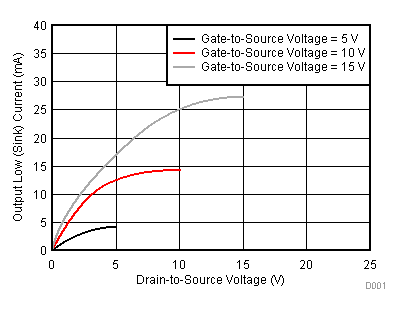 Figure 1. Typical Output Low (Sink)
Figure 1. Typical Output Low (Sink)Current Characteristics
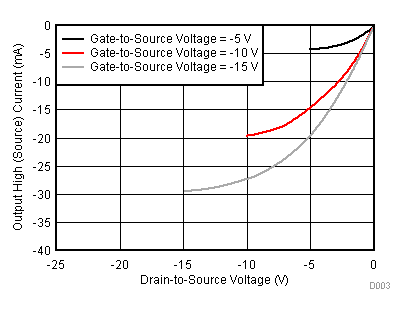 Figure 3. Typical Output High (Source)
Figure 3. Typical Output High (Source)Current Characteristics
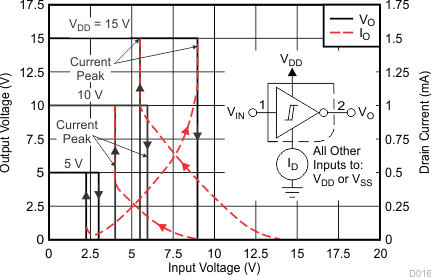 Figure 5. Typical Current and Voltage
Figure 5. Typical Current and VoltageTransfer Characteristics
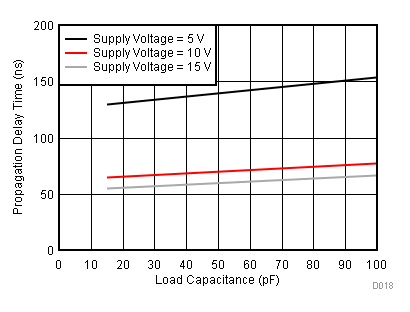 Figure 7. Typical Propagation Delay Time as a
Figure 7. Typical Propagation Delay Time as aFunction of Load Capacitance
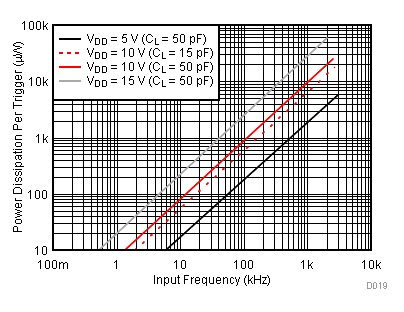 Figure 9. Typical Power Dissipation Per Trigger as a
Figure 9. Typical Power Dissipation Per Trigger as aFunction of Input Frequency
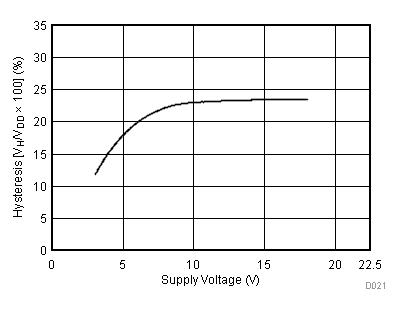 Figure 11. Typical Percent Hysteresis as a Function of Supply Voltage
Figure 11. Typical Percent Hysteresis as a Function of Supply Voltage
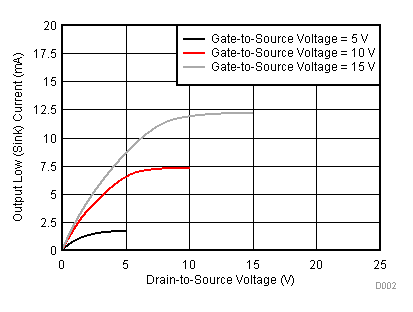 Figure 2. Minimum Output Low (Sink)
Figure 2. Minimum Output Low (Sink)Current Characteristics
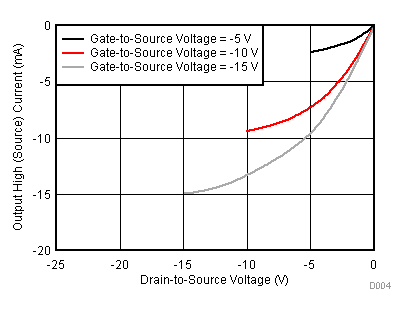 Figure 4. Minimum Output High (Source)
Figure 4. Minimum Output High (Source)Current Characteristics
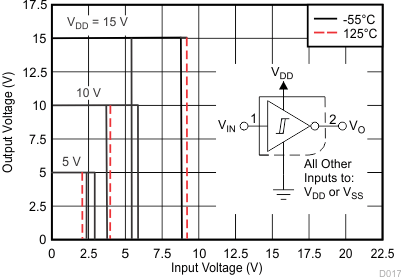 Figure 6. Typical Voltage Transfer Characteristics as a
Figure 6. Typical Voltage Transfer Characteristics as aFunction of Temperature
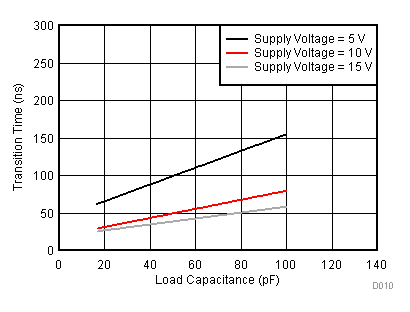 Figure 8. Typical Transition Time as a
Figure 8. Typical Transition Time as aFunction of Load Capacitance
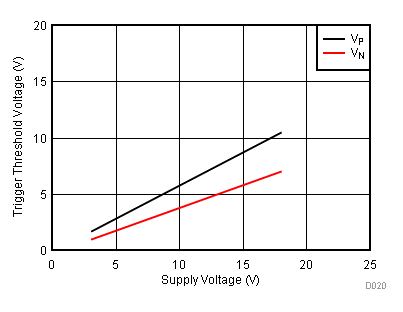 Figure 10. Typical Trigger Threshold Voltage as a
Figure 10. Typical Trigger Threshold Voltage as aFunction of Supply Voltage